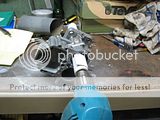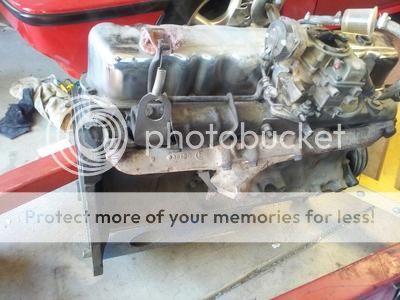1983gtturbo":274azgnp said:
Thanks for all the info. What I want to do is remove all the smog stuff off the motor. I was thinking of changing the intake and exhust manifold to a pre smog year which im thinkg in the early 70's. I really dont want to change the head so my guess is that a intake and exhust manifold would all be the same from the 60's-70's and would bolt to my 83 head. How would I be sure, I have done a few searches on line but nothing really says yes or no. Any idea where I can find this info?
:thanks:
I don't advocate removing smog stuff ever, but that's just me. Smog gear is just 4 percent off the performance of a small i6. If you are stuck with an 8.4:1 compression and AIR/EGR and fuel control valve and the other 12 emissions devices, you can still make 175 hp with the right cam,emissions era 2-bbl carb and exhast work. If you plane the head the maximum amount (100 to 120 thou) and use a 25 thou steel gasket and the right pistons, you can skyrocket the compression up to 13:1 and get 220 hp out of a 3.3 just using pump grade 87 octane and anti detonation water or alchol injection. The later big chamber head is great for flow, but it is down 20 cfm on the smaller chamber cc of a planed head. Everytime you plane a head, it gets closer to the better early 144/170/200 C1 code 52 cc heads, which flowed even better when planed 120 thou. At that, you have a 34 cc head which is 20 cfm up on the stock 105 cfm flow rate figure at 25" H20. Even an old 1960 to 1965 small chamber head flows better nthan the bigger camber 1965 to 1969 heads. The later heads flow better and have larger intake valves, but they lose compression ratio, and even with 1.65 early valve heads, they are about line ball for power. When you start planeing a later post 75 large intake valve, large log head, and opening up the log for extra carburation, you then start showing huge gains in power and cfm, but stock, the smaller logs early logs with higher compression are still pretty good items, especially when you hog the log out for better induction systems. In any case, you can make what is there on a Fox or late model X body work as good as the best small log, it just means you have to raise the compression a little.
In some cases, 120 thou removed by planing is close to junking a Ford I6 iron head, but 100 thou leaves a little room for further future work. Any time you plane a Ford I6 head, you gain cfm, reduced flame travel and as long as your ignition timing is pegged back for total advance, and ramped up for static timing to beyound what is stated on the emissions tag, you'll avoid detonation and pinking if you use the recomended advance ramps I've discussed in my ignition posts.
The exhast that is there on post 80 Foxes is the best exhast Ford ever made for I6's, and its regularly bagged because its not understood. In long wheel base Fox Fords (105.5 and 108.4" 80-82 Tbirds, most Fairmonts, most Granadas, most Zephyrs and most conpact LTD's) the B and X code engine didn't always get the screen converter.
The screen converter is a primary cat on some 3.3 and 4.1 engines, or a "foot ball converter" as its called often. It was cfm just a fine gauze item in the heat shield which carried an O2 sensor and in the days of leaded fuel, it would clog up when an Unleaded 3.3 was repeat miss filled with Lead gas.
Now, if you remove the primary cat, or your car is the long wheel base Fox without it, you can put in a splitter and a dual outlet exhast using either two 2" pipes routed around the low or even the high mount starter, they were still being made as options until 1983. Or your keep that passenger side exhast, and just add one front drive 4FC twin cam Toyota Corolla or Chevy Nova flexiable cross over pipe which runs the front exhast under the sump on AE92 Toyota based cars. It allows you to run a full dual exhast system V8 style with the stock V8 hookups like on the performance V8 Foxs and SN 95's, just like this one.
http://i1215.photobucket.com/albums/cc5 ... G_3827.jpg
http://i1215.photobucket.com/albums/cc5 ... G_3826.jpg
http://i1215.photobucket.com/albums/cc5 ... G_3825.jpg
http://i1215.photobucket.com/albums/cc5 ... G_3824.jpg
http://i1215.photobucket.com/albums/cc5 ... G_3823.jpg
http://i1215.photobucket.com/albums/cc5 ... G_3822.jpg
http://i1215.photobucket.com/albums/cc5 ... G_3821.jpg
All you have to do is put a flat plate and two 2 or even 2.125" pipes out of the exsiting 4.25" iron header, and run a vertical splitter plate from the flange on up to the ports between exhast 3 and 4, and your stock large log will flow like a dual out 4.9 EFI or 230/250 cube OHC Pontiac. I've studied a lot of engine dyno reports of I6 engines with this type of header, and a benchmark was the ancient GM Holden 179 X2/186S/161-186-202 GTR Torana dual out header. The dyno figures on all i6's show that a dual out iron exhast makes more power if the ports are short; they don't
need long branches. By the same token, if you run a heat shield to remove exhast heat, and use a set of any long branch header, you don't loose top end power, but
you to loose low end torque unless you have a certain type of header. I've discussed this before. The stock 4.25" log exhast used on 80's era Henries is just fine as a performance piece, and if done right, it can eclipse tube headers, BUT I'M NOT BAGGIN' TUBE HEADERS ON SMALL I6'S, okay?
See
viewtopic.php?f=5&t=5554&p=38262&hilit=+how+aussies+build%2A+#p38262
The idea with the six is to use a heat shield to cover the exhast header heat, like Peaugeot Bills race car Fox Mustang
http://i1215.photobucket.com/albums/cc5 ... ecar02.jpg
, or Mustang Geezers early log headed I6.
Then you add a triad of 278 to 435 cfm 55 to 79 GM Rochester 2 Jet carbs and a big single paper element air cleaner for the ultimate sleeper 3.3, or just a routed out 5200 Holley Weber which is normally a 269 cfm carb at 3.0" Hg flow pressure with the small venturis of the 2.3 liter 1980 Fords Fox Lima engine, or a 291 cfm at 3.0" Hg carb from the 1970 to 1979 2.3 liter Ford Pintos, MUSTANG II and Foxes, or Capris and Fox Capris. When Ford used either the 2.6 and 2.8 Cologne V6's, it had 291 cfm form from 1974 to 1980 in it. When modifed for maximum flow, you get a 350 cfm at 3.0 " Hg carb with 30 and 31 mm routed out holes, up from the 26 and 27 mm they had stock.

Thats the same flow as a 7448 Holley 350 2-bbl, but a stock emissions era carb that doesn't mind a really big 274 degree camshaft.










 for all the info, so from what I understand I can use an late 60's early 70's non smog intake and exhaust manifolds on my current 83 motor. All the vacume lines and current smog and EGR valves dont work the lines are all cracked and the smog pump is locked up. So I removed almost everything and capped off anything that at this point cant be removed. I want a clean look to the engine. Cars runs 100% better, replaced any remaing need vacume lines as well as any rubber lines that need to be replaced. So the last part is to remove the primery CAT as well as the one under the car. We have NO emmision testing in FL so its not like I need it. :thanks:
for all the info, so from what I understand I can use an late 60's early 70's non smog intake and exhaust manifolds on my current 83 motor. All the vacume lines and current smog and EGR valves dont work the lines are all cracked and the smog pump is locked up. So I removed almost everything and capped off anything that at this point cant be removed. I want a clean look to the engine. Cars runs 100% better, replaced any remaing need vacume lines as well as any rubber lines that need to be replaced. So the last part is to remove the primery CAT as well as the one under the car. We have NO emmision testing in FL so its not like I need it. :thanks:


